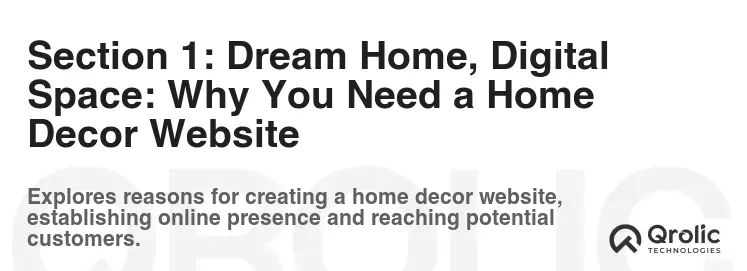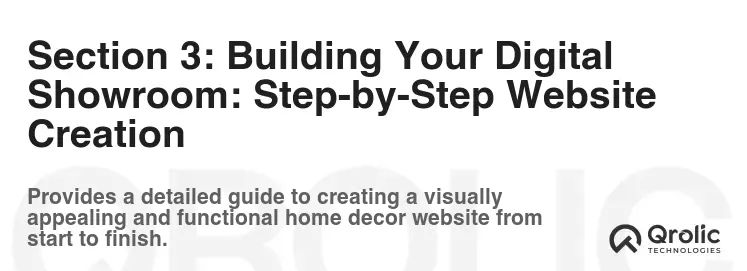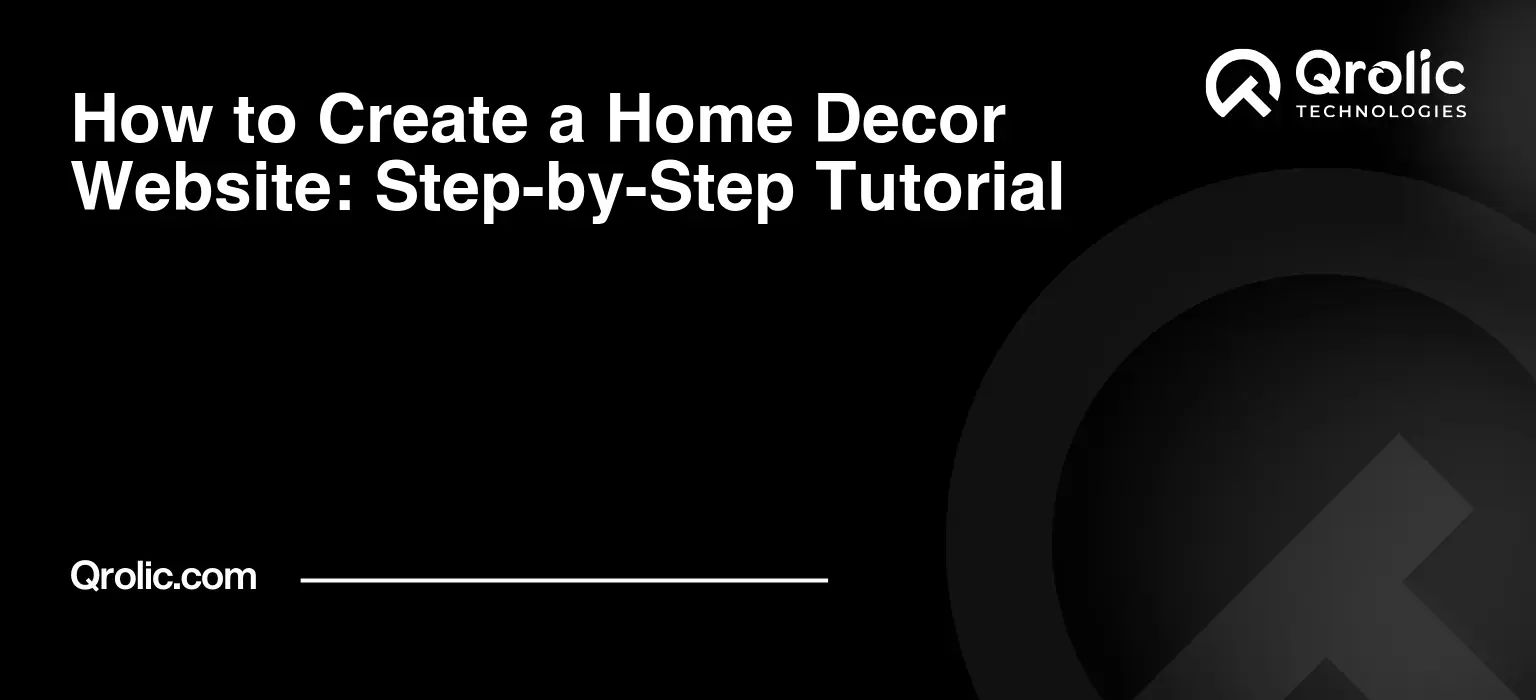Table of Contents
- Section 1: Dream Home, Digital Space: Why You Need a Home Decor Website
- 1.1 Beyond the Catalog: The Power of Online Presence for Home Decor
- 1.2 Who Needs a Home Decor Website?
- 1.3 What Can You Sell or Offer on a Home Decor Website?
- Section 2: Laying the Foundation: Planning Your Home Decor Website
- 2.1 Defining Your Niche and Target Audience
- 2.2 Website Goals and Objectives
- 2.3 Competitor Analysis: Learning from the Best (and the Worst)
- 2.4 Website Structure and Navigation: User Experience is King
- 2.5 Content Strategy: What to Say and How to Say It
- Section 3: Building Your Digital Showroom: Step-by-Step Website Creation
- 3.1 Choosing the Right Platform: Website Builders vs. CMS
- 3.2 Setting Up Your WordPress Website: Hosting, Domain, and Installation
- 3.3 Designing Your Website: Creating a Visually Appealing Experience
- 3.4 Setting Up Your Online Store (If Applicable): WooCommerce Configuration
- 3.5 Adding Content: Pages, Blog Posts, and Portfolio Items
- 3.6 Integrating Essential Tools: Analytics, Email Marketing, and Social Media
- Section 4: Polishing the Gem: Optimizing for SEO and User Experience
- 4.1 Keyword Optimization: Targeting the Right Search Terms
- 4.2 Mobile-Friendliness: A Must-Have in Today’s World
- 4.3 Page Speed Optimization: Keeping Visitors Engaged
- 4.4 User Experience (UX) Design: Making it Easy to Shop
- Section 5: Showcasing Your Expertise: Content Marketing for Home Decor
- 5.1 Blogging: Sharing Your Knowledge and Passion
- 5.2 Creating Engaging Visual Content: Photos, Videos, and Infographics
- 5.3 Leveraging Social Media: Reaching Your Target Audience
- 5.4 Email Marketing: Building Relationships with Your Customers
- Section 6: Qrolic Technologies: Your Partner in Digital Transformation
- Section 7: Maintaining and Growing Your Website: Long-Term Success
- 7.1 Website Security: Protecting Your Business and Customers
- 7.2 Website Updates: Keeping Your Content Fresh
- 7.3 Analyzing Your Results: Using Data to Make Decisions
- 7.4 Staying Up-to-Date with Trends: Adapting to the Changing Landscape
Section 1: Dream Home, Digital Space: Why You Need a Home Decor Website

1.1 Beyond the Catalog: The Power of Online Presence for Home Decor
The world has moved online. People aren’t just flipping through catalogs anymore; they’re scrolling, clicking, and discovering inspiration for their homes on the internet. A home decor website isn’t just a fancy addition; it’s the cornerstone of reaching modern customers, building a brand, and scaling your business. But why is it so vital?
- Expand Your Reach: Your physical store (if you have one) has limitations. An online presence allows you to connect with potential customers globally. Imagine decorating homes in London from your workshop in California. That’s the power of the internet.
- 24/7 Showroom: Forget opening hours. Your website is always open, showcasing your products and services day and night. Customers can browse at their leisure, increasing the chances of a sale.
- Brand Building & Authority: A well-designed website builds trust and credibility. It’s your digital business card, showcasing your expertise and style. It positions you as an authority in the home decor world.
- Targeted Marketing: Websites allow for sophisticated marketing tactics. You can use SEO (search engine optimization), social media, and email marketing to reach specific customer segments interested in particular styles or products.
- Direct Sales & E-commerce: Sell your products directly through your website. Cut out the middleman and increase your profit margins.
- Showcase Your Portfolio: Display stunning photos of your interior design projects, before-and-after transformations, and customer testimonials. Visuals are crucial in the home decor industry.
- Gather Customer Insights: Use analytics tools to understand your website visitors’ behavior. What products are they looking at? What content do they engage with? Use this data to improve your website and marketing efforts.
1.2 Who Needs a Home Decor Website?
This isn’t just for big businesses. A home decor website can benefit:
- Interior Designers: Showcase your portfolio, attract new clients, and manage projects.
- Furniture Stores: Sell your furniture online, reach a wider audience, and offer online consultations.
- Home Decor Product Retailers: Sell everything from rugs and lamps to wall art and accessories.
- DIY Home Decor Bloggers: Share your tutorials, promote your affiliate links, and sell your own digital products.
- Home Stagers: Attract real estate agents and homeowners looking to stage their properties for sale.
- Artisans & Makers: Sell your handcrafted home decor items directly to customers.
1.3 What Can You Sell or Offer on a Home Decor Website?
Think beyond just physical products. You can diversify your offerings to create multiple income streams and cater to a wider range of customers.
- Physical Products: Furniture, lighting, rugs, textiles, wall art, accessories, plants, and more.
- Digital Products: E-books, design templates, online courses, downloadable prints, and mood boards.
- Services: Interior design consultations, home staging services, virtual room design, color consultations, and personal shopping.
- Affiliate Marketing: Promote other companies’ products and earn a commission on each sale.
- Advertising: Sell advertising space on your website to other businesses in the home decor industry.
Section 2: Laying the Foundation: Planning Your Home Decor Website

Before diving into the technical aspects, it’s crucial to have a solid plan. This will save you time, money, and headaches down the road.
2.1 Defining Your Niche and Target Audience
Who are you trying to reach? What specific style or product category do you specialize in? Defining your niche will help you attract the right audience and differentiate yourself from the competition.
- Niche Examples: Modern farmhouse decor, minimalist Scandinavian design, bohemian style, eco-friendly home decor, luxury home decor, kids’ room decor.
- Target Audience Examples: Young professionals, families with children, homeowners renovating their properties, interior design enthusiasts, eco-conscious consumers.
Understanding your target audience involves considering their demographics (age, location, income), psychographics (interests, values, lifestyle), and online behavior (where they spend their time online, what type of content they consume).
2.2 Website Goals and Objectives
What do you want to achieve with your website? Be specific and measurable.
- Examples:
- Increase online sales by 20% in the next quarter.
- Generate 50 qualified leads per month for interior design services.
- Grow website traffic by 30% in the next year.
- Build an email list of 1,000 subscribers in the next six months.
2.3 Competitor Analysis: Learning from the Best (and the Worst)
Research your competitors to see what they’re doing well and where they’re falling short.
- Identify Key Competitors: Use search engines and social media to find websites that offer similar products or services.
- Analyze Their Websites: Evaluate their design, content, navigation, pricing, and marketing strategies.
- Identify Their Strengths and Weaknesses: What are they doing better than you? What areas could they improve on?
- Look for Opportunities: How can you differentiate yourself from the competition? What unique value can you offer to your customers?
2.4 Website Structure and Navigation: User Experience is King
Plan the structure of your website to ensure it’s easy to navigate and user-friendly.
- Essential Pages:
- Homepage: The first impression. Showcase your best products, services, and brand message.
- About Us: Tell your story, build trust, and connect with your audience on a personal level.
- Products/Shop: Display your products with high-quality images, detailed descriptions, and clear pricing.
- Services: Describe your interior design services, home staging services, or other offerings.
- Portfolio: Showcase your past projects with stunning photos and testimonials.
- Blog: Share valuable content related to home decor, design trends, and DIY projects.
- Contact Us: Provide your contact information and a contact form for inquiries.
- Intuitive Navigation: Use clear and concise menu labels. Make it easy for visitors to find what they’re looking for.
- Site Map: Create a site map to help search engines crawl and index your website.
- Mobile-Friendly Design: Ensure your website is responsive and looks good on all devices (desktops, tablets, and smartphones).
2.5 Content Strategy: What to Say and How to Say It
Your website content is crucial for attracting visitors, engaging them, and converting them into customers.
- Keyword Research: Identify the keywords that your target audience is using to search for home decor products and services. Use tools like Google Keyword Planner, SEMrush, and Ahrefs.
- Compelling Headlines: Write headlines that grab attention and entice visitors to read more.
- High-Quality Images and Videos: Visuals are essential in the home decor industry. Use professional photos and videos to showcase your products and projects.
- Informative and Engaging Content: Provide valuable information about your products, services, and the latest home decor trends.
- Call to Action: Encourage visitors to take action, such as making a purchase, requesting a consultation, or subscribing to your email list.
Section 3: Building Your Digital Showroom: Step-by-Step Website Creation

Now for the exciting part: bringing your vision to life! Here’s a step-by-step guide to creating your home decor website.
3.1 Choosing the Right Platform: Website Builders vs. CMS
You have two main options for building your website:
- Website Builders (e.g., Wix, Squarespace): These are user-friendly platforms that offer drag-and-drop interfaces and pre-designed templates. They’re ideal for beginners who want to get a website up and running quickly.
- Pros: Easy to use, no coding required, affordable pricing plans.
- Cons: Limited customization options, less control over your website’s code.
- Content Management Systems (CMS) (e.g., WordPress, Joomla, Drupal): These are more powerful platforms that offer greater flexibility and customization. They’re ideal for businesses that need more control over their website’s design and functionality. WordPress is the most popular CMS, powering over 40% of all websites on the internet.
- Pros: Highly customizable, wide range of plugins and themes, excellent SEO capabilities.
- Cons: Steeper learning curve, requires some technical knowledge.
Recommendation: For most home decor businesses, WordPress is the best option. It offers the perfect balance of flexibility, control, and ease of use.
3.2 Setting Up Your WordPress Website: Hosting, Domain, and Installation
If you’ve chosen WordPress, here’s how to get started:
- Choose a Web Hosting Provider: Web hosting is where your website files are stored. Choose a reliable hosting provider that offers good performance, security, and customer support. Popular options include:
- Bluehost
- SiteGround
- HostGator
- Kinsta
- Register a Domain Name: Your domain name is your website’s address (e.g., yourhomedecor.com). Choose a domain name that is memorable, relevant to your business, and easy to spell.
- Install WordPress: Most hosting providers offer a one-click WordPress installation. Follow their instructions to install WordPress on your hosting account.
- Choose a WordPress Theme: A WordPress theme is a pre-designed template that determines the look and feel of your website. There are thousands of free and premium themes available.
- Key Considerations:
- Responsiveness: Ensure the theme is mobile-friendly.
- Customization Options: Look for a theme that allows you to customize the colors, fonts, and layout.
- SEO-Friendliness: Choose a theme that is optimized for search engines.
- E-commerce Compatibility: If you plan to sell products online, choose a theme that is compatible with WooCommerce (a popular e-commerce plugin for WordPress).
- Popular Home Decor Themes:
- Astra
- OceanWP
- Divi
- Hello Elementor
- Key Considerations:
- Install Essential WordPress Plugins: Plugins are add-ons that extend the functionality of your website.
- Essential Plugins:
- WooCommerce: For e-commerce functionality.
- Yoast SEO: For SEO optimization.
- Contact Form 7: For creating contact forms.
- Akismet Anti-Spam: For preventing spam comments.
- Elementor (or similar page builder): For drag-and-drop page building.
- UpdraftPlus: For backing up your website.
- Essential Plugins:
3.3 Designing Your Website: Creating a Visually Appealing Experience
Design is crucial for a home decor website. Your website should be visually appealing, easy to navigate, and reflect your brand’s style.
- Use High-Quality Images: Invest in professional photos of your products, projects, and team.
- Choose a Consistent Color Palette: Use a color palette that complements your brand and creates a cohesive look and feel.
- Use White Space Effectively: White space (or negative space) is the empty space around elements on your website. It helps to improve readability and create a clean and modern design.
- Use Typography Strategically: Choose fonts that are easy to read and that complement your brand’s style.
- Create a User-Friendly Navigation: Make it easy for visitors to find what they’re looking for. Use clear and concise menu labels.
- Optimize for Mobile: Ensure your website is responsive and looks good on all devices.
3.4 Setting Up Your Online Store (If Applicable): WooCommerce Configuration
If you plan to sell products online, you’ll need to set up an online store using WooCommerce.
- Install and Activate WooCommerce: Install the WooCommerce plugin from the WordPress plugin directory and activate it.
- Configure WooCommerce Settings: Follow the WooCommerce setup wizard to configure your store settings, including:
- Store Address: Your physical store address (if applicable).
- Currency: Your store’s currency.
- Shipping Zones: Define your shipping zones and shipping rates.
- Payment Gateways: Choose your preferred payment gateways (e.g., PayPal, Stripe).
- Add Products: Add your products to your online store.
- Product Details: Include high-quality images, detailed descriptions, pricing, and inventory information.
- Product Categories and Tags: Organize your products into categories and tags to make it easier for customers to find what they’re looking for.
- Test Your Store: Place a test order to ensure that everything is working correctly.
3.5 Adding Content: Pages, Blog Posts, and Portfolio Items
Now it’s time to add content to your website.
- Homepage: Create a compelling homepage that showcases your best products, services, and brand message.
- About Us: Tell your story, build trust, and connect with your audience on a personal level.
- Products/Shop: Display your products with high-quality images, detailed descriptions, and clear pricing.
- Services: Describe your interior design services, home staging services, or other offerings.
- Portfolio: Showcase your past projects with stunning photos and testimonials.
- Blog: Share valuable content related to home decor, design trends, and DIY projects.
- Contact Us: Provide your contact information and a contact form for inquiries.
3.6 Integrating Essential Tools: Analytics, Email Marketing, and Social Media
Integrate essential tools to track your website’s performance, engage with your audience, and promote your business.
- Google Analytics: Track your website traffic, user behavior, and conversion rates.
- Email Marketing Platform (e.g., Mailchimp, ConvertKit): Build an email list and send newsletters, promotions, and other marketing messages to your subscribers.
- Social Media Integration: Connect your website to your social media accounts. Make it easy for visitors to share your content on social media.
- Live Chat Software (e.g., Tawk.to, Zendesk Chat): Provide real-time customer support.
Section 4: Polishing the Gem: Optimizing for SEO and User Experience

Once your website is built, it’s time to optimize it for search engines and user experience.
4.1 Keyword Optimization: Targeting the Right Search Terms
Optimize your website for the keywords that your target audience is using to search for home decor products and services.
- Keyword Research: Use tools like Google Keyword Planner, SEMrush, and Ahrefs to identify relevant keywords.
- On-Page Optimization:
- Title Tags: Include your target keywords in your title tags.
- Meta Descriptions: Write compelling meta descriptions that entice visitors to click on your website in the search results.
- Header Tags (H1-H6): Use header tags to structure your content and include your target keywords.
- Image Alt Text: Add descriptive alt text to your images that includes your target keywords.
- Content: Write high-quality, informative content that is optimized for your target keywords.
- Off-Page Optimization:
- Link Building: Build high-quality backlinks from other websites in your industry.
- Social Media Marketing: Promote your website on social media.
- Local SEO: If you have a physical store, optimize your website for local search.
4.2 Mobile-Friendliness: A Must-Have in Today’s World
Ensure your website is responsive and looks good on all devices. Mobile-friendliness is a ranking factor for Google.
- Use a Responsive Theme: Choose a WordPress theme that is designed to be responsive.
- Test Your Website on Different Devices: Use Google’s Mobile-Friendly Test tool to check if your website is mobile-friendly.
- Optimize Images for Mobile: Compress your images to reduce file size and improve loading speed on mobile devices.
4.3 Page Speed Optimization: Keeping Visitors Engaged
Website loading speed is crucial for user experience and SEO. Slow-loading websites can frustrate visitors and negatively impact your search engine rankings.
- Use a Fast Hosting Provider: Choose a hosting provider that offers good performance.
- Optimize Images: Compress your images to reduce file size.
- Use a Content Delivery Network (CDN): A CDN can help to improve your website’s loading speed by caching your website’s content on servers around the world.
- Minimize HTTP Requests: Reduce the number of HTTP requests by combining CSS and JavaScript files.
- Enable Browser Caching: Enable browser caching to store static assets in the user’s browser.
4.4 User Experience (UX) Design: Making it Easy to Shop
A positive user experience is crucial for converting visitors into customers.
- Clear Navigation: Make it easy for visitors to find what they’re looking for.
- Easy-to-Use Search Function: Implement a search function that allows visitors to easily search for products and services.
- High-Quality Product Images: Use professional photos of your products.
- Detailed Product Descriptions: Provide detailed descriptions of your products, including dimensions, materials, and care instructions.
- Clear Pricing and Shipping Information: Display your pricing and shipping information clearly.
- Easy Checkout Process: Make the checkout process as simple and straightforward as possible.
- Customer Reviews: Encourage customers to leave reviews of your products and services.
Section 5: Showcasing Your Expertise: Content Marketing for Home Decor

Content marketing is a powerful way to attract visitors to your website, engage them, and establish yourself as an authority in the home decor industry.
5.1 Blogging: Sharing Your Knowledge and Passion
Start a blog and share valuable content related to home decor, design trends, and DIY projects.
- Blog Post Ideas:
- “Top 10 Home Decor Trends for 2024”
- “How to Choose the Right Rug for Your Living Room”
- “DIY Home Decor Projects on a Budget”
- “The Ultimate Guide to Minimalist Interior Design”
- “How to Style Your Bookshelves Like a Pro”
- Write High-Quality Content: Write informative, engaging, and well-written blog posts.
- Optimize Your Blog Posts for SEO: Use relevant keywords in your title tags, meta descriptions, header tags, and content.
- Promote Your Blog Posts: Share your blog posts on social media, email newsletters, and other channels.
5.2 Creating Engaging Visual Content: Photos, Videos, and Infographics
Visual content is essential in the home decor industry. Use high-quality photos, videos, and infographics to showcase your products and projects.
- Product Photography: Invest in professional product photography to showcase your products in the best possible light.
- Interior Design Photography: Share stunning photos of your interior design projects.
- Video Tutorials: Create video tutorials on DIY home decor projects and design tips.
- Infographics: Create infographics that summarize complex information in a visually appealing way.
5.3 Leveraging Social Media: Reaching Your Target Audience
Use social media to connect with your target audience, promote your website, and share your content.
- Choose the Right Social Media Platforms: Focus on the platforms where your target audience is most active.
- Share High-Quality Content: Share engaging content that is relevant to your audience.
- Engage with Your Followers: Respond to comments and messages. Ask questions and start conversations.
- Run Contests and Giveaways: Run contests and giveaways to attract new followers and generate buzz.
- Use Social Media Advertising: Use social media advertising to reach a wider audience.
5.4 Email Marketing: Building Relationships with Your Customers
Build an email list and send newsletters, promotions, and other marketing messages to your subscribers.
- Offer a Lead Magnet: Offer a free e-book, discount code, or other valuable resource in exchange for email addresses.
- Send Regular Newsletters: Send regular newsletters with valuable content, product updates, and special offers.
- Segment Your Email List: Segment your email list based on interests and demographics to send more targeted messages.
- Personalize Your Emails: Personalize your emails with the subscriber’s name and other information.
- Track Your Email Performance: Track your email open rates, click-through rates, and conversion rates.
Section 6: Qrolic Technologies: Your Partner in Digital Transformation

At Qrolic Technologies (https://qrolic.com/), we understand the unique challenges and opportunities that home decor businesses face in the digital landscape. We are a team of experienced web developers, designers, and marketers who are passionate about helping businesses like yours succeed online.
How Qrolic Technologies Can Help You:
- Custom Website Development: We can build a custom home decor website that is tailored to your specific needs and goals.
- E-commerce Development: We can help you set up an online store that is easy to use and optimized for conversions.
- SEO Services: We can help you improve your website’s search engine rankings and attract more organic traffic.
- Content Marketing Services: We can help you create and promote high-quality content that engages your audience and establishes you as an authority in the home decor industry.
- Social Media Marketing: We can help you manage your social media accounts and reach a wider audience.
- Website Maintenance and Support: We offer ongoing website maintenance and support to ensure that your website is always up-to-date and running smoothly.
Why Choose Qrolic Technologies?
- Experience: We have years of experience working with home decor businesses.
- Expertise: We have a team of skilled web developers, designers, and marketers.
- Results-Driven: We are focused on helping you achieve your business goals.
- Customer-Focused: We are committed to providing excellent customer service.
- Affordable Pricing: We offer competitive pricing plans to fit your budget.
Contact us today to learn more about how Qrolic Technologies can help you create a successful home decor website.
Section 7: Maintaining and Growing Your Website: Long-Term Success

Creating a website is just the first step. To ensure long-term success, you need to maintain and grow your website.
7.1 Website Security: Protecting Your Business and Customers
Website security is crucial for protecting your business and your customers’ data.
- Use a Strong Password: Use a strong password for your WordPress account and all other website accounts.
- Keep Your Software Up-to-Date: Keep your WordPress core, themes, and plugins up-to-date.
- Install a Security Plugin: Install a security plugin to protect your website from malware and other threats.
- Use an SSL Certificate: An SSL certificate encrypts the data that is transmitted between your website and your visitors’ browsers.
- Back Up Your Website Regularly: Back up your website regularly to protect your data in case of a security breach.
7.2 Website Updates: Keeping Your Content Fresh
Keep your website content fresh and up-to-date.
- Update Your Product Listings: Regularly update your product listings with new products, pricing information, and descriptions.
- Publish New Blog Posts: Publish new blog posts regularly to keep your website content fresh and engage your audience.
- Update Your Portfolio: Update your portfolio with your latest projects.
- Review and Update Your Website Content: Review and update your website content regularly to ensure that it is accurate and relevant.
7.3 Analyzing Your Results: Using Data to Make Decisions
Track your website’s performance and use data to make decisions.
- Google Analytics: Use Google Analytics to track your website traffic, user behavior, and conversion rates.
- WooCommerce Analytics: Use WooCommerce Analytics to track your online store’s performance.
- Email Marketing Analytics: Track your email open rates, click-through rates, and conversion rates.
- Social Media Analytics: Track your social media engagement and reach.
Use this data to identify areas for improvement and make data-driven decisions.
7.4 Staying Up-to-Date with Trends: Adapting to the Changing Landscape
The home decor industry is constantly evolving. Stay up-to-date with the latest trends and adapt your website and marketing strategies accordingly.
- Follow Home Decor Blogs and Magazines: Follow leading home decor blogs and magazines to stay up-to-date with the latest trends.
- Attend Industry Events: Attend industry events to network with other professionals and learn about new products and technologies.
- Monitor Social Media: Monitor social media to see what people are talking about.
- Experiment with New Technologies: Experiment with new technologies to improve your website and marketing efforts.
By following these steps, you can create a successful home decor website that attracts visitors, engages them, and converts them into customers. Remember to focus on providing value to your audience, building a strong brand, and constantly improving your website and marketing strategies. Good luck!






